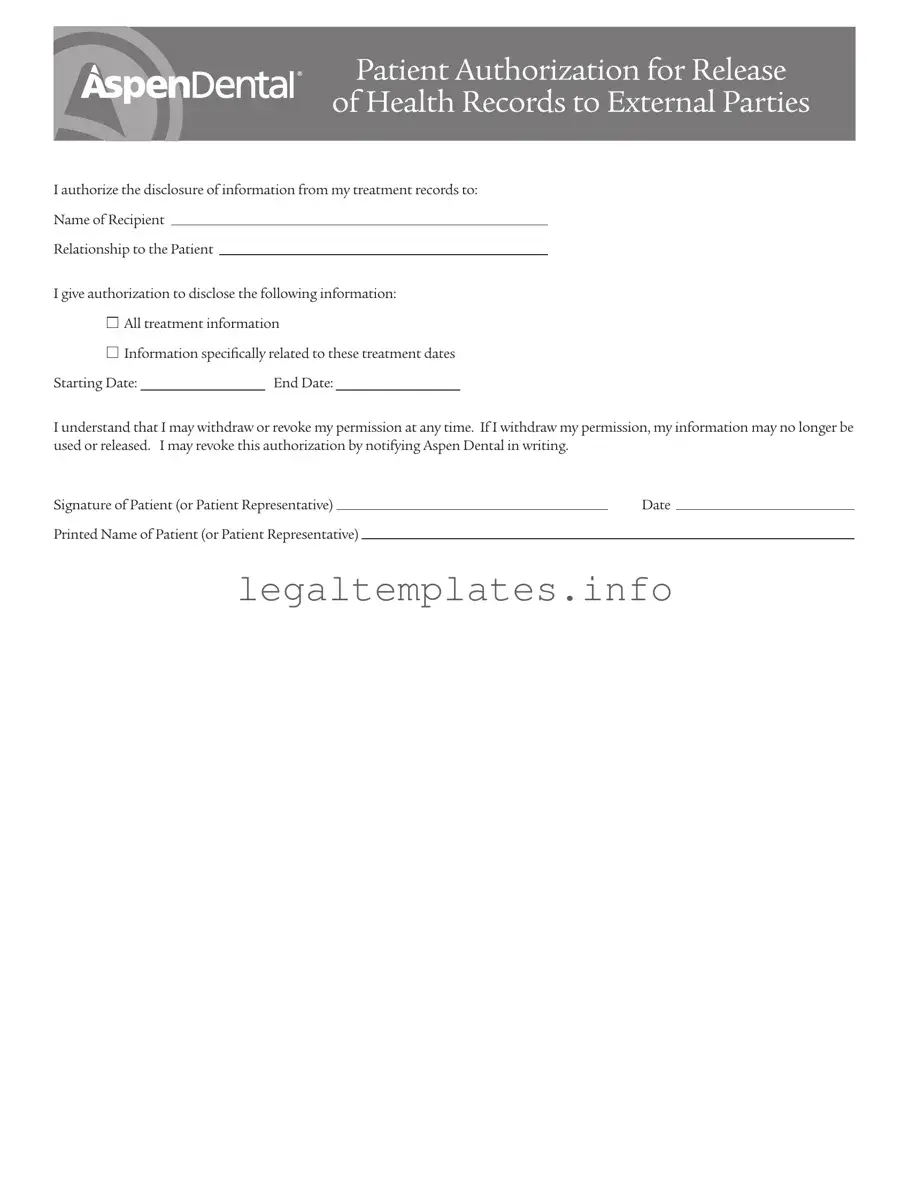The Aspen Dental Health Information Release form shares similarities with the General Medical Release Form, which is commonly used in the healthcare sector. Both forms serve the essential function of authorizing the release and sharing of personal health records and treatment information with specified parties. The General Medical Release Form, like its counterpart from Aspen Dental, often includes fields for identifying the patient and recipient, the scope of information to be disclosed, and conditions under which the authorization can be revoked. This form is a basic tool in managing privacy and access to one's medical history.
Another document that parallels the Aspen Dental form is the HIPAA Release Form. This form is grounded in the Health Insurance Portability and Accountability Act (HIPAA), focusing on the protection of patient health information. It specifically allows healthcare providers to share patient information for treatment, payment, or healthcare operations unless the patient explicitly revokes permission. Like the Aspen Dental form, it includes sections for detailing what information can be shared, with whom, and under what circumstances the authorization can be withdrawn, emphasizing patient control over their medical information.
The Mental Health Records Release Form is also akin to the Aspen Dental document but is more specific in its application. It permits the dissemination of sensitive mental health information to designated parties. Although the content focus differs — centering on mental health rather than general or dental health — the structure is similar. Both documents require patient authorization, clearly state the information to be released, and allow for revocation of the permission, ensuring patient rights and privacy are upheld in sensitive situations.
The School Immunization Records Release Form, encountered frequently by educational institutions and parents, similarly echoes the structure and intent of the Aspen Dental form. This document authorizes the release of a student's immunization history to schools to fulfill enrollment requirements. While the content is specifically tailored to immunization records, the core elements of patient identification, third-party identification, and consent revocation are consistent across both forms, demonstrating their role in information sharing within regulated contexts.
A Legal Testimony Authorization Form, often utilized within legal proceedings, also shares characteristics with the Aspen Dental Health Information Release form. This document grants permission for medical information to be used as evidence in court. Despite its more specific legal application, the emphasis on detailed patient consent, information boundaries, and the ability to revoke permission mirrors the Aspen Dental document’s approach to managing and releasing personal health information responsibly and with patient consent.
A Substance Abuse Treatment Information Release Form, found within specialized medical and therapeutic environments, resembles the Aspen Dental form by focusing on a particular type of health information. It permits the release of records related to substance abuse treatment to specified individuals or entities. Despite the niche focus, fundamental aspects such as specifying what information can be disclosed, to whom, and the patient's right to rescind the authorization, align it closely with the general structure and purpose of the Aspen Dental form.
Finally, the School Physical Examination Records Release Form, which is a document allowing the sharing of a child's physical exam results with their school, bears resemblance. While tailored for a school setting and specific to physical exams, the form retains the basic structure seen in the Aspen Dental Health Information Release form — specifying the scope of information release, identifying recipient parties, and ensuring provisions are in place for the sender to revoke consent at any time. This focus on secure, consent-based information sharing is a fundamental aspect shared across these documents.

